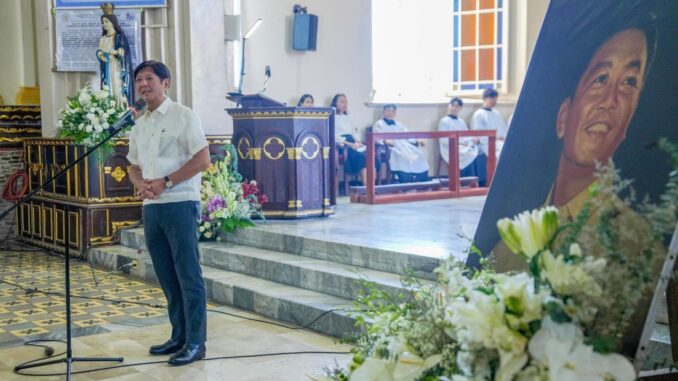
MANILA, Philippines — Records and investigations the US government have long discredited Ferdinand Marcos Sr.’s claims of heroism during World War II, but his son and namesake has proclaimed that his feats are recorded with the Central Intelligence Agency.
While celebrating Marcos Day in his bailiwick of Ilocos Norte on Wednesday, September 11, President Ferdinand Marcos Jr. fondly recalled Marcos Sr.’s love for the country, saying he often looked to his father for wisdom. He had declared Marcos Day a holiday in the province, commemorating Marcos Sr.’s birthday.
The president recalled one of his visits to the US, where he claimed to have met with the director of the CIA. Marcos Jr. said he then asked the director if he could see his father’s files with the Office of Strategic Service (OSS), the precursor to the CIA.
“I asked them: ‘Can I see some of the records about my father when he was working with the OSS?’” Marcos said in a mix of English and Filipino.
“They allowed me. They took me to the records room and they started to show me many of the records, the reports that were given during the war that are still secret. And I mean he was greater than even we realized. The things that he did, the things that — the sacrifices that he made for the Philippines,” Marcos Jr. said.
Marcos Jr. said he asked the CIA if he could take the records home, but they told him the files remain classified.
Purported CIA meeting, documents
Marcos Jr. has made four official visits to the United States since he became president in 2022. On these trips, he went to New York, Washington DC, Arlington in Virginia, San Francisco and Los Angeles in California as well as Honolulu, Hawaii.
It is not on public record that he met with the CIA director, William J. Burns, whose headquarters is in Langley, Virginia. But Marcos did visit the Pentagon in Arlington.
While the meeting could have taken place in any of these venues, it is difficult to independently verify Marcos Jr’s account of his meeting with Burns, and the existence of classified records.
The CIA’s website, however, has reposted a New York Times article from Jan. 23, 1986 titled “Marcos’s Wartime Role Discredited in US Files” by Jeff Gerth and Joel Brinkley.
It says that during the Japanese occupation from 1942 to 1944, Marcos Sr. claimed to have headed a guerilla resistance known as “Ang Mga Maharlika.”
Journalists who conducted interviews and looked through files cited US Army officers rejecting Marcos Sr.’s requests for recognition, as his accounts did not have factual support. In some submissions, Ang Mga Maharlika was said to have 300 men, while others claimed the group had 8,300.
“Marcos was never the leader of a large guerilla organization. No way. Nothing like that could have happened without my knowledge,” retired US Army Capt. Ray Hunt, who directed guerilla activities in Pangasinan, said in the report.
Other US Army officials flagged other inconsistencies with Marcos Sr.’s claims. US Army Capt. Elbert Curtis, who investigated the claims, called the assertion that Maharlika operated across the entire island of Luzon “absurd.”
“Captain Curtis wrote that there was no mention of Maharlika being a source of intelligence information,” the report read. “He wrote that the unit roster was a fabrication, that ‘no such unit ever existe’ and thatt Mr. Marcos’s claims about Maharlika were ‘fraudulent,’ ‘preposterous’ and a ‘malicious criminal act.”
How the CIA viewed Marcos Sr.
While supposed classified records with the CIA could support Marcos Sr’s wartime records, as Marcos Jr. claims, a story from the Washington Post in 1986 by George Lardner Jr. presents impressions members of the agency have of his father.
The article titled “Ex-CIA Agent Recalls Marcos’ Rise to Power” posted on the CIA website suggests that a former CIA agent, Joseph Smith, saw the young politician as “unscrupulous” in 1959, years after Marcos Sr. supposedly served in the guerilla.
Smith was in charge of a CIA campaign to influence the Philippine senatorial elections to sway it toward their favored candidates, according to Lardner.
“If only we’d had the guts to stick by [former president Ramon] Magasaysay’s boys. They were really quite different from the Marcos crowd, the landed elite,” Smith said.
“I felt he was a fairly cagey fellow with not a great deal of scruples,” Smith added, referring to Marcos Sr.
The Marcosian legacy
In his speech on Wednesday’s Marcos Day ceremony in his hometown, Marcos Jr. said his father’s legacy was of service.
“The greatest service that he could do was to serve the entire country of the Philippines. So, if we are to continue on this important legacy that he has left us. What again will be our guide? How again do we know what is the right path to make it better for the Philippines? To make life better for all Filipinos,” Marcos Jr. said.
The Marcos family was ousted from power during the 1986 People Power Revolution after two decades of Martial Law under Marcos Sr., regarded as a dictator, whose rule was marked by human rights abuses and rampant corruption.
Yet history has not closed its chapter on the Marcoses. Their return to power was a slow climb, beginning from local seats of power in Ilocos Norte and the north in the early 1990s all the way back to Malacañan Palace in 2022.
Now, with Marcos Sr.’s daughter Sen. Imee Marcos in the Senate, their cousin Martin Romualdez helming the House of Representatives, and Marcos Jr. assuming at same seat of power his father once held, Marcos Sr.’s legacy is once again being evoked.
During his presidential campaign and throughout his tenure, Marcos Jr. has drawn upon the memory of his father.
“I’m always reminded of what was engraved in the museleo when my father was still buried here,” Marcos Jr. said, referring to the mausoleum in Ilocos where the waxen corpse of his father used to lay. “And those of you that have been to the mausoleum will remember that it was one single word—Filipino. And that is the essence of my father.”





Be the first to comment